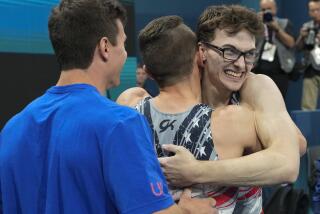In Blind Nationals, Athletes Prove Themselves
- Share via
Janet Rowley probably wouldn’t be bothered if you called her a dumb jock. She can handle that stereotype.
Label her as simply a “blind athlete,” however, and watch the sparks fly. She’ll let you know she’s an athlete before she’s blind.
Rowley is one of 357 athletes from 37 states and two foreign countries in the 10th Blind Nationals. The event, which features seven sports at Cal State Long Beach, began Monday and runs through Saturday.
Rowley, from Boston, is one of several who have competed with a great deal of success against non-disabled opponents. But more than once, Rowley has had to dispel the notion that a deficiency in sight equates a deficiency in athletic ability.
Worse yet, she said, there are those who don’t care to find out.
When Rowley went out for the Boston University track team, she was asked to take a physical. She passed each test, until she was placed in front of the eye chart.
“I said, ‘Where is the chart?’ ” she said. A week later, Rowley received a letter saying she was unable to run track.
Rowley’s sight is classified as B2, able to distinguish a hand from a hamburger when placed in front of her face.
Eventually, she pushed her way onto the team. And though her sight is a fraction of what the ordinary range is, she does recognize a high jump bar, and at one regional meet in 1978 she took a bronze medal for leaping 5-feet, and a gold in the discus for a throw of 30 meters.
The point of her story, Rowley said, is the point of the Blind Nationals--that the disabled are capable if given the opportunity.
“People have their own blinds on, their own misconceptions,” said Rowley, 27, who holds world records for the blind in the discus and the high jump. “In a lot of events, there is no skill difference. The difference is in coaching. You can’t just show a videotape to a blind athlete and say, ‘OK, now go do that.’ ”
Rowley said that blind athletes are too often institutionalized, removed from athletic activity. Such was what she encountered in elementary school.
“They’re afraid to give blind athletes a challenge . . . afraid of the liability,” she said. “One of my biggest frustrations is the lack of coaching available and knowing where to go find it.”
The athletes are divided into three sight categories: B1, B2 and B3. The severely blind are B1, while those in B3 have relatively good vision but are still legally blind.
Forty-four winners in two sports, swimming and track and field, will go on to represent the United States at the World Championships in Goteborg, Sweden, from Aug. 2-17.
“The initial thrust of this was to provide competition for athletes unable to get it in the public school systems,” said Dick Anderson, director of the track and field events. “This is good therapy, good rehabilitation. It makes them feel like they still can do something worthwhile.
“People automatically assume blind people have limits, but you should say, ‘Well, what can you do?’ ”
More to Read
Go beyond the scoreboard
Get the latest on L.A.'s teams in the daily Sports Report newsletter.
You may occasionally receive promotional content from the Los Angeles Times.










